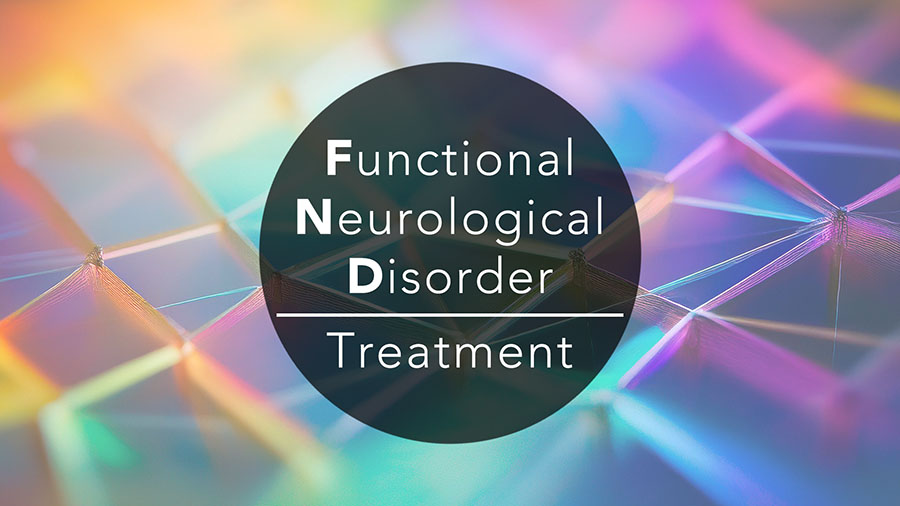If you’re a patient working with an occupational therapist for functional neurological disorder (FND), we want you to be as informed as possible—so we, as OTs, can truly partner to create the best course of treatment for YOU.

In occupational therapy, we often work from “menus” of evidence-based assessments and treatments. This gives us the flexibility to meet the specific needs of each patient, while still following research-backed care protocols. Below, you’ll see the assessment and treatment options your therapist may use, along with the evidence that supports them.
Please note that this page is for educational purposes and should not substitute advice from your healthcare provider(s). At the bottom of this page, you’ll find therapists near you who can support you in your FND treatment.
A quick note on why to pursue therapy
FND treatment is typically delivered by a multidisciplinary team that can include OT.
Occupational therapists specialize in providing holistic, personalized treatments for the mind and body that are designed to progress your overall independence.
This is done through client-focused, therapist-led treatments that improve your ability to re-engage in tasks such as dressing, feeding yourself, going to school or work, or participating in preferred activities.
Ideally, conservative treatment like rehabilitation therapy—including OT—is the first course of care for FND.
That is because therapy is safer and much more cost-effective than invasive options like surgery, investigative treatments, and medications—which may also involve a long list of rule-out testing and unnecessary specialist visits (when patients actually meet the criteria for FND).
Studies show that annual costs (both direct and indirect) associated with FND range from $5K–$86K (USD) per patient due to delayed diagnoses, stigmatization of the disorder, and inadequate medical education—which can lead to high utilization of healthcare resources, including hospital and emergency department services (Mahoney et al., 2023; Watson et al., 2023). With timely diagnosis and treatment focused on symptom management and quality of life, there is potential to reduce this cost significantly (by 9–91%) (Mahoney et al., 2023).
And, we believe that occupational therapy is an essential, often-missing element of FND care.
The number of therapy sessions needed will vary based on the results of your initial evaluation. In general, the greater your initial disability, the more frequent your sessions—and potentially, the longer you will attend therapy. Some models of care include intensives, where you attend therapy more frequently for a short period of time. You will collaborate with your therapist during your initial evaluation to determine the best care plan for you. Note that future episodes of therapy care may be required, though a personalized home program will allow for increasing self-management after you finish therapy—empowering you to optimize your outcomes and return to functional activities long-term. (Read more about this in the discharge section below.)
Therapist-recommended assessments for FND
As you will see below, evaluating a case of functional neurological disorder involves much more than simply assessing the physical body. Typically, multiple body systems are involved, and your OT evaluation aims to consider the whole picture. That way, your therapist can better understand where to focus treatment.
Occupational therapists utilize standardized tests to identify current functional levels, measure progress, and develop goals tailored to your individual treatment. Below are a few assessments that your therapist may ask you to complete throughout care:
General Functional Assessments
- Canadian occupational performance measure (COPM)1
- Rand-36 item quality of life scale
- Quick DASH
- COMPASS-31 (autonomic symptom score)
- FIM Scale
- WeeFIM scale
- The Model of Human Occupation Screening Tool1
- The Worker Role Interview1
- Occupational circumstances assessment interview and rating scale1
- The Assessment of Motor and Process Skills (AMPS)1
- General occupational screening and interview
- Range of motion (less likely to correlate with function)2
- Manual muscle testing (less likely to correlate with function)2
- Self-efficacy scales (e.g., self-efficacy for exercise, general self-efficacy scale)
Symptom Specific Assessments
- FND assessment for positive signs
- Active range of motion assessment (during functional tasks)
- Adolescent/Adult Sensory Profile1
- Pain Catastrophizing Scale
- Headache Disability Index (HDI)
- Lower Extremity Functional Scale
- Upper Extremity Functional Index
- Nine-Hole Peg Test
- Sleep log
- Modified Fatigue Impact Scale
Mental Health Screens
- Perceived Stress Scale
- Hospital Anxiety and Depression Scale (HADS)
- Generalized Anxiety Disorder-7 (GAD-7)
Setting goals for FND therapy
Therapy is most successful when patients and therapists work together to set goals. It is essential that you collaborate with your therapist to determine treatment goals that truly reflect what’s important to you. Before your occupational therapy evaluation, it may be helpful to consider the following:
- What areas of daily life are currently challenging for me?
- What are my top 5 biggest functional challenges, concerns, or priority areas?
- What does a typical 24-hour routine look like for me?
- What are my strengths?
- What approaches have been successful in maximizing my function or ability to complete tasks in my daily life?
Therapy treatment interventions for FND
After a thorough evaluation and goal-setting process, it is time to start making progress. Below are treatment interventions that your provider may utilize in a holistic occupational therapy program.
- Therapeutic relationship and rapport building 4
- Education for patients, family, and caregivers 1,2,3,5,6
- Collaborative outline of the systems and contributing factors to FND presentation (e.g., physical, psychological, social, lifestyle, and autonomic) 2,6
- Assessment of 24-hour routine 1,2,4,6
- Education about patterns that may negatively affect the ability to adapt
- Stress and anxiety management 1
- Retraining of normal movement within function 1
- Unlock automatic movement
- Shift to an external focus of attention 2,4
- Utilize preferred activities and interests
- Use the brain to the individual’s advantage by multi-tasking with fidgets or other sensory inputs
- Exercise and practice targeted movement 1,2
- Strategies to regulate the autonomic nervous system (e.g., mind-body connection, fight/flight, and rest/digest)
- Biofeedback, or insight into the body’s functioning through the use of technology that measures things like muscle tension, breathing and heart rate, body temperature, or sweat
- Sensory sensitivity assessment to determine treatment for hyper- or hypo-sensitivity
- Education and practice in energy management and pacing skills to manage fatigue and symptom flares2
- Education on pain management strategies 1,2
- Desensitization may be indicated in some cases
- Sleep hygiene and routines to address sleep challenges 6
- Daily activity engagement (e.g., dressing, feeding, hygiene)
- Exploration of accommodations and options for work, school, or volunteerism 1,6
- Exploration and participation in new or old hobbies and fun activities 6
- Social engagement and brainstorming solutions for challenges
- Cognitive rehabilitation for challenges with “brain fog” and thinking limitations 1
- Support for self-management1
Discharge suggestions
Each individual is unique; therefore, each patient’s response to therapy will also be unique. With FND, it often is not appropriate to continue therapy until you see a complete resolution of symptoms. Some individuals will see significant progress early in therapy; for others, it will take time to make noticeable gains. Many individuals benefit from breaks in care before returning to focus on certain goals. Regardless, we do know that self-management and integration of a home program into one’s lifestyle is essential.
- Collaborate with your therapist leading up to discharge to gather recommendations that will help you maintain progress made in therapy. This could include:
- Personalized self-management strategies
- Plans for activity engagement on good days versus tougher days
- Consistent routine engagement
- Adapted aide usage plan
- Identification of your support system
- Continue to use self-management and empowerment strategies to manage remaining challenges.
- Follow a consistent, individualized home program.
- Consult your therapist if your symptoms worsen—or if you continue to have difficulty with daily activities and believe a new episode of care would be helpful.
More Education Options for FND
If you are looking for more education on FND, here are some websites you may find helpful:
Choosing an occupational therapist for FND
Occupational therapists, physical therapists, and psychologists are often essential members of the care team for individuals with FND. Here, we describe the role of an occupational therapist in FND treatment.
Occupational therapists have a graduate degree specializing in occupational therapy (typically a master’s degree or a clinical doctorate), meaning they have 5–8 years of post-secondary education (in the United States; other countries have different educational requirements).
Below, you can find occupational therapy professionals who have tagged “FND” as a focus area. You can also access the “find a provider” resource from FNDHope.org or call local therapy clinics in your area to inquire about the FND treatment they offer.
Though many OTs do not specialize in FND, their training is sufficient to engage a wide variety patients in individualized interventions to help improve function, regardless of diagnosis. You can further maximize your success and the therapist’s approach by sharing this page with them and referencing the additional continuing education options and resources provided here.
Conclusion
Hopefully, this article has helped you understand what occupational therapy for FND might look like—and whether you are a good candidate for OT!
This article is updated monthly based on newly published research. If you have any research you would like us to consider, please drop it in the comments.
Therapists in search of more detailed information and resources on FND treatment can join us as members of the OT Potential Club.

Article by
Emily Rich, PhD, OTRL, is a researcher, clinical specialist, and course instructor focusing on postural orthostatic tachycardia syndrome (POTS), Ehlers-Danlos syndromes (EDS)/hypermobility spectrum disorders, Parkinson’s disease, cancer rehab, and various chronic illnesses.

Reviewed by
Jason Kreuzman, MS, OTR/L, is a pediatric OT specializing in functional neurological disorder (FND) and chronic pain. He also is the current chair of the FND committee at St. Louis Children’s Hospital, a founding member of the FND Society, and co-chair of the FND Society Pediatric Special Interest Group (SIG).
Edited by
Brooke Andrus is the Head of Content at OT Potential, bringing over a decade of experience strategizing, building, and executing on content marketing plans for successful healthcare tech startups in the rehab therapy and behavioral health spaces.
References
Cost references
O’Mahony, B., Nielsen, G., Baxendale, S., Edwards, M. J., & Yogarajah, M. (2023). Economic cost of functional neurologic disorders: a systematic review. Neurology, 101(2), e202-e214.
Watson, M., Woodward, J., & Strom, L. A. (2023). The Financial Burden of Functional Neurological Disorders. Current Neurology and Neuroscience Reports, 23(10), 637-643.
Assessment and treatment references
Here’s the science that backs the assessment and treatment outlined above.
- Nicholson C, Edwards MJ, Carson AJ, et al. Occupational therapy consensus recommendations for functional neurological disorder. J Neurol Neurosurg Psychiatry. 2020. doi:10.1136/jnnp-2019-322281
- Nielsen G, Stone J, Matthews A, et al. Physiotherapy for functional motor disorders: a consensus recommendation. J Neurol Neurosurg Psychiatry. 2015. doi:10.1136/jnnp-2014-309255
- Aybek S, Perez DL. Diagnosis and management of functional neurological disorder. BMJ. 2022. doi:10.1136/bmj.o64
- Gray N, Savage B, Scher S, Kozlowska K. Psychologically Informed Physical Therapy for Children and Adolescents With Functional Neurological Symptoms: The Wellness Approach. J Neuropsychiatry Clin Neurosci. 2020.
- Kozlowska K, Sawchuk T, Waugh JL, et al. Changing the culture of care for children and adolescents with functional neurological disorder. Epilepsy Behav Rep. 2021.
- Vassilopoulos A, Mohammad S, Dure L, Kozlowska K, Fobian AD. Treatment Approaches for Functional Neurological Disorders in Children. Curr Treat Options Neurol. 2022.
- Nisticò V, Iacono A, Goeta D, et al. Hypermobile spectrum disorders symptoms in patients with functional neurological disorders and autism spectrum disorders: A preliminary study. Front Psychiatry. 2022.
- Blitshteyn S, Treisman GJ, Ruhoy IS, et al. Postural orthostatic tachycardia syndrome and other common autonomic disorders are not functional neurologic disorders. Front Neurol. 2024.
OT Potential does not endorse any treatments, procedures, products, or therapists referenced herein. This information is provided as an educational service and is not intended to serve as medical advice. Anyone seeking medical advice should consult their medical provider.

